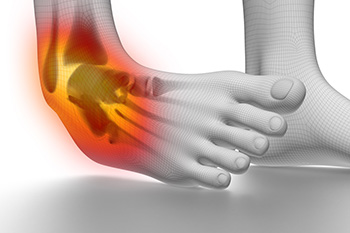 Severe ankle sprains that do not respond well to conservative treatment methods, such as rest and elevation, may require surgical intervention to restore stability and function to the ankle. A podiatrist, or foot doctor, might suggest surgical procedures like arthroscopy, where a small camera and instruments are inserted through tiny incisions to visualize, diagnose, and repair damage to the ligaments inside the ankle. Severe tearing of the ligaments may require reconstructive surgery, which involves replacing the damaged ligament with a tendon graft taken from another part of the body or using synthetic materials to stabilize the ankle. These surgical options aim to alleviate pain, restore stability, and prevent chronic issues such as ankle instability or recurrent sprains. Post-surgery, a rehabilitation program with targeted exercises to strengthen the muscles around the ankle is important. This helps patients who have undergone ankle surgery regain full mobility and recover successfully. If you have a sprained ankle, it is suggested that you make an appointment with a podiatrist promptly for proper care.
Severe ankle sprains that do not respond well to conservative treatment methods, such as rest and elevation, may require surgical intervention to restore stability and function to the ankle. A podiatrist, or foot doctor, might suggest surgical procedures like arthroscopy, where a small camera and instruments are inserted through tiny incisions to visualize, diagnose, and repair damage to the ligaments inside the ankle. Severe tearing of the ligaments may require reconstructive surgery, which involves replacing the damaged ligament with a tendon graft taken from another part of the body or using synthetic materials to stabilize the ankle. These surgical options aim to alleviate pain, restore stability, and prevent chronic issues such as ankle instability or recurrent sprains. Post-surgery, a rehabilitation program with targeted exercises to strengthen the muscles around the ankle is important. This helps patients who have undergone ankle surgery regain full mobility and recover successfully. If you have a sprained ankle, it is suggested that you make an appointment with a podiatrist promptly for proper care.
Foot surgery is sometimes necessary to treat a foot ailment. To learn more, contact Howard Waxman, DPM of Pleasant Valley Podiatry. Our doctor will assist you with all of your foot and ankle needs.
When Is Surgery Necessary?
Foot and ankle surgery is generally reserved for cases in which less invasive, conservative procedures have failed to alleviate the problem. Some of the cases in which surgery may be necessary include:
What Types of Surgery Are There?
The type of surgery you receive will depend on the nature of the problem you have. Some of the possible surgeries include:
Benefits of Surgery
Although surgery is usually a last resort, it can provide more complete pain relief compared to non-surgical methods and may allow you to finally resume full activity.
Surgical techniques have also become increasingly sophisticated. Techniques like endoscopic surgery allow for smaller incisions and faster recovery times.
If you have any questions please feel free to contact one of our offices located in Willoughby Hills and Broadview Heights, OH . We offer the newest diagnostic and treatment technologies for all your foot and ankle needs.

Sweaty feet, medically known as plantar hyperhidrosis, can be a source of discomfort and embarrassment for many individuals. Several factors contribute to this common condition. One primary reason is the presence of sweat glands on the soles of the feet. These glands produce sweat to regulate body temperature and keep the skin moist. However, excessive sweating can occur from over-stimulation of these glands, often triggered by factors like hot weather, physical activity, stress, or hormonal changes. Wearing tight or non-breathable shoes can also worsen the problem by trapping moisture and heat, which creates an ideal environment for bacterial and fungal growth. Additionally, certain medical conditions, such as hyperthyroidism or diabetes, may contribute to excessive sweating. Fortunately, there are various strategies to manage sweaty feet, including wearing breathable footwear, practicing good hygiene, using antiperspirant foot sprays or powders, and seeking medical treatment from a podiatrist. If you are experiencing excessively sweaty feet, it is suggested that you a podiatris who can offer you effective relief and management tips.
If you are suffering from hyperhidrosis contact Howard Waxman, DPM of Pleasant Valley Podiatry. Our doctor can provide the care you need to attend to all of your foot and ankle needs.
Hyperhidrosis of the Feet
Hyperhidrosis is a rare disorder that can cause people to have excessive sweating of their feet. This can usually occur all on its own without rigorous activity involved. People who suffer from hyperhidrosis may also experience sweaty palms.
Although it is said that sweating is a healthy process meant to cool down the body temperature and to maintain a proper internal temperature, hyperhidrosis may prove to be a huge hindrance on a person’s everyday life.
Plantar hyperhidrosis is considered to be the main form of hyperhidrosis. Secondary hyperhidrosis can refer to sweating that occurs in areas other than the feet or hands and armpits. Often this may be a sign of it being related to another medical condition such as menopause, hyperthyroidism and even Parkinson’s disease.
In order to alleviate this condition, it is important to see your doctor so that they may prescribe the necessary medications so that you can begin to live a normal life again. If this is left untreated, it is said that it will persist throughout an individual’s life.
A last resort approach would be surgery, but it is best to speak with your doctor to find out what may be the best treatment for you.
If you have any questions please feel free to contact one of our offices located in Willoughby Hills and Broadview Heights, OH . We offer the newest diagnostic and treatment technologies for all your foot and ankle needs.

Plantar warts, though often considered minor nuisances, hold interesting facts worth exploring. These warts, caused by the human papillomavirus, or HPV, commonly appear on the soles of the feet, particularly in areas subjected to pressure or friction. Unlike other warts, plantar warts grow inward due to the pressure exerted by walking, leading to a flattened appearance. They may present as small, grainy growths or larger, cauliflower-like clusters. Plantar warts can be painful, especially while walking or standing, as they press into the skin and nerves. Despite their viral origin, they are not highly contagious and are more likely to develop in individuals with weakened immune systems or through direct contact with contaminated surfaces. If you have a plantar wart, it is suggested that you consult a podiatrist who can offer you the treatment option that is right for you.
Plantar warts can be very uncomfortable. If you need your feet checked, contact Howard Waxman, DPM from Pleasant Valley Podiatry. Our doctor will assist you with all of your foot and ankle needs.
About Plantar Warts
Plantar warts are the result of HPV, or human papillomavirus, getting into open wounds on the feet. They are mostly found on the heels or balls of the feet.
While plantar warts are generally harmless, those experiencing excessive pain or those suffering from diabetes or a compromised immune system require immediate medical care. Plantar warts are easily diagnosed, usually through scraping off a bit of rough skin or by getting a biopsy.
Symptoms
Treatment
To help prevent developing plantar warts, avoid walking barefoot over abrasive surfaces that can cause cuts or wounds for HPV to get into. Avoiding direct contact with other warts, as well as not picking or rubbing existing warts, can help prevent the further spread of plantar warts. However, if you think you have developed plantar warts, speak to your podiatrist. He or she can diagnose the warts on your feet and recommend the appropriate treatment options.
If you have any questions please feel free to contact one of our offices located in Willoughby Hills and Broadview Heights, OH . We offer the newest diagnostic and treatment technologies for all your foot and ankle needs.

Blisters between the toes can be a real pain, whether they're caused by friction, insect bites, burns, or infections. These little pockets of fluid can make each step a challenge. Friction is often the main cause of blisters between the toes. When your toes rub against each other or your shoes, the skin becomes irritated and leads to blister formation. Other causes of blisters between the toes include insect bites, burns, and various infections. While most blisters will heal on their own within a week or two, it's essential to resist the urge to pop them. Breaking a blister can increase the risk of infection and prolong the healing process. Instead, keep the blister clean and covered with a bandage. If the blister is particularly painful or shows signs of infection, it's best to seek medical attention from a podiatrist. Preventing blisters between the toes starts with wearing properly fitting shoes and socks. Avoid walking long distances in new shoes, and be sure to change socks if they become damp. If you have persistent or severe blisters between the toes, it is suggested that you seek help from a podiatrist for relief.
Blisters may appear as a single bubble or in a cluster. They can cause a lot of pain and may be filled with pus, blood, or watery serum. If your feet are hurting, contact Howard Waxman, DPM of Pleasant Valley Podiatry. Our doctor can provide the care you need to keep you pain-free and on your feet.
Foot Blisters
Foot blisters are often the result of friction. This happens due to the constant rubbing from shoes, which can lead to pain.
What Are Foot Blisters?
A foot blister is a small fluid-filled pocket that forms on the upper-most layer of the skin. Blisters are filled with clear fluid and can lead to blood drainage or pus if the area becomes infected.
Symptoms
(Blister symptoms may vary depending on what is causing them)
Prevention & Treatment
In order to prevent blisters, you should be sure to wear comfortable shoes with socks that cushion your feet and absorb sweat. Breaking a blister open may increase your chances of developing an infection. However, if your blister breaks, you should wash the area with soap and water immediately and then apply a bandage to the affected area. If your blisters cause severe pain it is important that you call your podiatrist right away.
If you have any questions, please feel free to contact one of our offices located in Willoughby Hills and Broadview Heights, OH . We offer the newest diagnostic and treatment technologies for all your foot care needs.